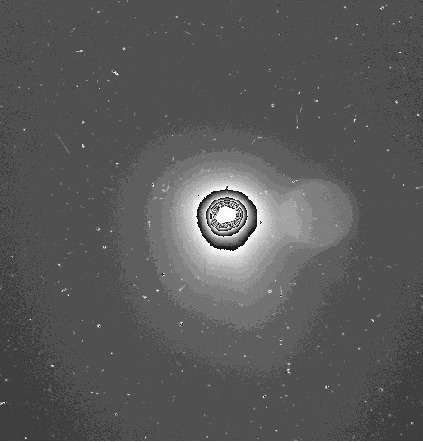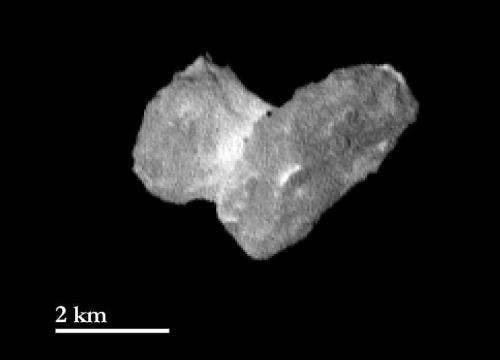A distinct coma surrounds comet 67P/Churyumov-Gerasimenko as seen from Rosetta

(Phys.org) —Less than a week before Rosetta's rendezvous with comet 67P/Churyumov-Gerasimenko, images obtained by OSIRIS, the spacecraft's onboard scientific imaging system, show clear signs of a coma surrounding the comet's nucleus. While OSIRIS' view of the coma covers an area of 150 kilometers across, its outskirts might reach much farther.
"Even though it sounds like a contradiction, imaging the comet's coma from nearby is more difficult than from far away", says OSIRIS Principal Investigator Holger Sierks from the Max Planck Institute for Solar System Research (MPS) in Germany. At the end of April, for example, OSIRIS had witnessed a distinct rise of cometary dust production from a distance of more than two million kilometers. At that time, one pixel in OSIRIS' images corresponded to a region in space covering 2500 square kilometers at the nucleus. The reflected light from all dust particles seen in this column worked together to create a signal. Now, as the resolution of OSIRIS images increases, a much smaller region ? and thus far less dust particles ? contributes to one pixel.
Nevertheless, a new image dating from July 25th clearly reveals an extended coma shrouding 67P's nucleus. "Our coma images cover an area of 150 by 150 square kilometers", says Luisa Lara from the Instituto de Astrofísica de Andalucía. However, most likely these images show only the inner part of the coma, where particle densities are highest. Scientists expect 67P's full coma to actually reach much farther.
Another challenge for OSIRIS is the bright nucleus that outshines the surrounding coma. While OSIRIS is designed to deal with a controlled overexposure in the region of the nucleus, the stray light from this strong source causes artifacts by the optical system. In the current image, the hazy bright circular structure to the right of the comet's nucleus is such an artifact. The center of the image located around the position of the nucleus is obscured by overexposure.

In the next weeks, the OSIRIS team will study how the comet's activity has developed so far in approach. To this end, data obtained from different distances and with different exposure times need to be correlated.
Meanwhile, new images of the comet's nucleus confirm the collar-like appearance of the neck region which presents itself brighter than most parts of the comet's body and head. The reason for this feature is still subject to discussion. Possible explanations range from differences in material or grain size to topological effects.
Rosetta is an ESA mission with contributions from its member states and NASA. Rosetta's Philae lander is provided by a consortium led by DLR, MPS, CNES and ASI. Rosetta will be the first mission in history to rendezvous with a comet, escort it as it orbits the Sun, and deploy a lander to its surface.
Provided by Max Planck Society




















